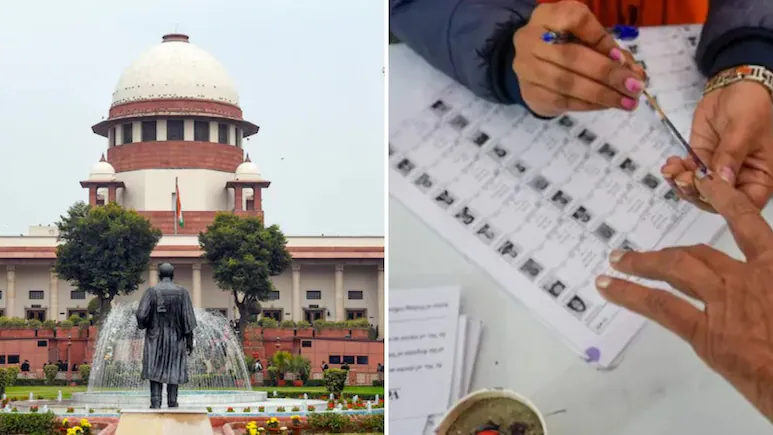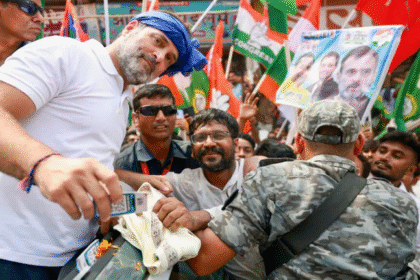Supreme Court Defends Bihar Voter List Revision as ‘Not Anti-Voter’ — A Comprehensive Analysis
In a significant development shaping India’s electoral landscape, the Supreme Court of India has clarified that the ongoing revision of the Bihar voter list under the Special Intensive Revision (SIR) process is “not anti-voter.” Addressing concerns raised by petitioners and political observers, the Court asserted that the procedural changes — including the expansion of acceptable identity documents from seven to eleven — are designed to strengthen voter inclusion and maintain the integrity of the electoral roll.
This statement is not only crucial for Bihar’s political environment ahead of upcoming elections but also holds nationwide implications for how voter list revisions are perceived and implemented. In this multi-part, in-depth report, we examine the Supreme Court’s rationale, the procedural aspects of the revision, the historical context of voter list reforms in India, and the potential political, social, and legal outcomes.
Background: Why the Bihar Voter List Revision Matters
The Bihar voter list revision process has been under public and political scrutiny for several months. Initiated under the guidance of the Election Commission of India (ECI), the revision is part of a broader effort to ensure that electoral rolls are accurate, updated, and inclusive of all eligible citizens.
Bihar’s socio-political dynamics make this process particularly sensitive. As one of India’s most populous states, Bihar’s electorate is diverse — including large rural populations, migrant workers, and marginalized communities. Even a small administrative change in the voter registration process can influence millions of potential votes.
Concerns raised in petitions and public discourse ranged from fears of voter suppression to allegations that the revised norms might disproportionately affect certain socio-economic groups. Against this backdrop, the Supreme Court’s intervention carried weight.
The Supreme Court’s Key Statement: “Not Anti-Voter”
The Court’s assertion that the process is “not anti-voter” carries legal and symbolic significance. By making this declaration, the Court effectively addressed two main issues:
- Intent of the Revision
The Court noted that expanding the list of acceptable documents from seven to eleven was not intended to restrict access but to broaden it. The addition of more document options makes it easier for citizens who may not possess certain traditional IDs to still register and vote. - Safeguarding Electoral Integrity
While inclusivity is a priority, the Court underscored that accuracy in the voter list is equally essential. Fraudulent entries, duplicates, or outdated records undermine the democratic process. The SIR process is designed to balance inclusivity with authenticity.
Understanding the Special Intensive Revision (SIR) Process
The Special Intensive Revision is a targeted exercise undertaken by the Election Commission to comprehensively update voter rolls ahead of significant elections. The SIR typically involves:
- Door-to-door verification of voters.
- Public display of draft electoral rolls for objections and corrections.
- Acceptance of multiple forms of identification for inclusion in the list.
- Mechanisms for removing ineligible names, such as deceased voters or duplicates.
For Bihar, the 2025 SIR is of exceptional importance given upcoming state-level elections and the state’s role in shaping national politics.
Why Document Expansion from 7 to 11 is Important
Previously, only seven types of documents were accepted for voter registration. The expansion to eleven is a deliberate attempt to remove administrative barriers for citizens. This decision aligns with the principle of universal suffrage by recognizing that documentation standards should adapt to ground realities, especially in states where access to certain IDs is inconsistent.
The four additional documents include certain government-issued certificates, employment records, and welfare program IDs — all of which cater to underrepresented segments of the population.
Legal and Constitutional Foundations
The Supreme Court’s statement rests on several constitutional principles:
- Article 326: Mandates that elections to the House of the People and to State Legislatures shall be based on adult suffrage.
- Article 14: Ensures equality before the law, implying no arbitrary exclusion of eligible voters.
- Representation of the People Act, 1950 & 1951: Lays down the legal framework for preparing and revising electoral rolls.
The Court’s interpretation emphasizes that administrative changes cannot contravene the spirit of these provisions. Instead, revisions must enhance voter access while upholding integrity.
Reactions from Stakeholders
Election Commission of India (ECI)
The ECI welcomed the judgment, reiterating that the SIR in Bihar is being conducted with maximum transparency. Officials noted that door-to-door campaigns, help desks, and awareness drives are in place to ensure every eligible citizen can register.
Political Parties
Reactions have been mixed. The ruling party in Bihar hailed the Supreme Court’s observation as validation of its governance. Opposition parties, however, expressed measured skepticism, urging continued vigilance to prevent potential disenfranchisement.
Civil Society and Activists
Several NGOs working on electoral rights praised the Court’s acknowledgment of inclusion but emphasized the need for on-ground monitoring to ensure that the expanded document list is actually accepted in practice.
Possible Implications for Upcoming Elections
The Supreme Court’s clarification could have several electoral consequences:
- Increased Voter Participation: By expanding document eligibility, more citizens may be able to register, especially in rural and economically disadvantaged areas.
- Reduction in Litigation: Legal disputes around voter list exclusions may decrease, given the Court’s authoritative stance.
- Political Strategy Shifts: Parties may need to reassess campaign strategies to appeal to newly registered voters.
Challenges That Remain
While the judgment addresses a significant portion of the controversy, challenges persist:
Implementation Gaps: Local-level officials may not uniformly apply the new document norms.
- Awareness Deficit: Many citizens remain unaware of the new provisions.
- Technology Barriers: Digital registration systems, while efficient, may exclude citizens lacking internet access.
The Supreme Court’s assertion that the Bihar voter list revision is “not anti-voter” marks a pivotal moment in India’s electoral administration. It reflects a judicial commitment to inclusive democracy while safeguarding electoral integrity.
In the next part of this series, we will delve into historical voter list controversies in India, analyze comparative international practices, and explore on-the-ground realities in Bihar’s voter registration process.
While the Supreme Court’s clarification on the Bihar voter list revision is a contemporary event, it cannot be fully understood without looking at India’s decades-long history of electoral roll management. From pre-Independence struggles for suffrage to recent technological reforms, voter registration in India has evolved through cycles of controversy, reform, and judicial oversight.
In this section, we trace the historical trajectory of voter list revisions, examine notable disputes that shaped policy, and compare India’s experience with global democratic practices to better understand why the Court’s “Not Anti-Voter” statement is significant.
Early History of Voter Registration in India
Before 1950, the right to vote in India was restricted by property ownership, education, and tax payment qualifications. This meant that millions of citizens — especially women, landless laborers, and marginalized communities — were excluded.
With the adoption of the Constitution of India in 1950, universal adult suffrage became a cornerstone of the nation’s democracy. Article 326 mandated that all citizens aged 21 or above (later reduced to 18 in 1988) would have the right to vote, regardless of caste, religion, gender, or wealth.
The Election Commission of India (ECI), formed in 1950, undertook the first nationwide electoral roll preparation, an exercise that revealed both the logistical complexity and political sensitivity of voter registration.
Major Voter List Controversies in Independent India
Over the decades, India has seen several disputes related to the accuracy, fairness, and inclusivity of voter lists.
1. Assam NRC and Voter List Exclusions
Perhaps the most high-profile recent case was the National Register of Citizens (NRC) in Assam. While not a traditional voter list revision, it significantly affected electoral rolls by identifying “genuine citizens.” Critics argued it led to mass disenfranchisement risks, while supporters saw it as a step toward integrity.
2. Andhra Pradesh and Telangana Purge Concerns
In 2014, after the bifurcation of Andhra Pradesh, allegations emerged that thousands of voters were wrongly removed from electoral rolls due to faulty database linking with Aadhaar numbers.
3. Urban Migrant Underrepresentation
Metropolitan cities like Mumbai, Delhi, and Bengaluru have consistently faced low voter registration rates among migrant populations due to rigid documentation requirements and frequent address changes.
4. Bihar’s Own Past Disputes
Bihar has experienced controversies in multiple election cycles, with opposition parties alleging manipulated deletions or additions in voter rolls to benefit ruling governments. These accusations have fueled skepticism toward any voter list revision in the state.
Judicial Interventions Shaping Voter List Policy
The Supreme Court and various High Courts have played an active role in defining voter registration norms.
- PUCL vs. Union of India (2003): Expanded voter rights by introducing the NOTA (None of the Above) option, emphasizing informed and inclusive participation.
- Common Cause vs. Union of India: Stressed the importance of accurate electoral rolls and ordered stricter verification mechanisms.
- Recent Bihar Case: The Court’s “Not Anti-Voter” observation fits into a tradition of balancing inclusivity with integrity.
Evolution of Identification Requirements
The list of acceptable documents for voter registration has expanded gradually:
- 1950s–1980s: Name, age, and address were verified mostly via manual village records or community verification.
- 1990s: Introduction of photo voter ID cards (EPIC) to curb impersonation.
- 2000s–2010s: Integration with other government databases like Aadhaar.
- 2020s: Flexible multi-document acceptance to address digital divide concerns.
The Supreme Court’s endorsement of expanding from seven to eleven documents reflects this long-term trend toward wider accessibility.
International Comparisons: How Other Democracies Handle Voter Registration
India’s voter list revision process, though complex, is not unique. Democracies worldwide grapple with similar issues.
United States
- Decentralized System: States maintain their own voter rolls, leading to inconsistencies.
- Controversy: Voter ID laws are hotly debated, with critics claiming they suppress minority turnout.
United Kingdom
- Rolling Registration: Citizens can register anytime, with annual checks.
- Challenge: High non-registration rates among young people and transient populations.
Australia
- Compulsory Voting: Citizens must register and vote or face penalties.
- Benefit: Maintains high voter participation rates but requires strict roll maintenance.
South Africa
- Post-Apartheid Inclusion Drive: Massive campaigns to register marginalized communities.
- Ongoing Issue: Maintaining updated records in rural areas remains difficult.
Compared to these systems, India’s approach is centrally managed, relatively uniform across states, and increasingly inclusive through document flexibility.
Bihar’s Socio-Political Landscape and Voter Inclusion
To fully appreciate the Court’s decision, one must understand Bihar’s unique electoral environment:
- High Rural Population: Over 80% of voters live in villages, often far from registration centers.
- Migrant Workforce: Millions work outside the state, complicating registration logistics.
- Caste and Community Dynamics: Voter lists are closely monitored by political actors due to caste-based voting patterns.
Any change in voter registration norms inevitably triggers political speculation about its possible effects on election outcomes.
Public Perception vs. Judicial Clarity
Public trust in voter list revisions often hinges on perceived political neutrality.
Even with the Supreme Court’s clarification, skepticism persists — not necessarily because of the ruling itself, but due to:
- Historical instances of exclusion.
- Inconsistent implementation at the local level.
- Political narratives framing the revision as beneficial to one side.
This trust deficit is why judicial endorsements carry so much weight.
While legal pronouncements and policy frameworks shape the foundation of electoral reforms, their true test lies in execution. Bihar’s Special Intensive Revision (SIR) process — currently underway — is an enormous logistical exercise. The Supreme Court may have deemed the revision “not anti-voter,” but its impact on the ground depends on how well election machinery translates policy into practice.
This part examines urban and rural implementation, the role of election officials, voter awareness campaigns, and the lived experiences of citizens navigating the revised norms.
The Scale of the Task
Bihar’s electoral roll encompasses over 7 crore registered voters across 38 districts. The revision aims to:
- Include all eligible citizens who turned 18 before the cut-off date.
- Correct errors in names, addresses, and ages.
- Remove ineligible or duplicate entries.
- Integrate newly accepted documents into the registration process.
This requires door-to-door verification, extensive paperwork, digital updates, and public display of draft rolls — all within a strict timeline set by the Election Commission of India (ECI).
Urban Implementation: Opportunities and Gaps
Ease of Access
In cities like Patna, Gaya, and Muzaffarpur, the revision process benefits from:
- Higher availability of trained staff.
- Better digital infrastructure.
- Greater media outreach to inform voters.
Challenges
- Migrant Workers: Many are absent during verification, requiring follow-up visits.
- Overcrowded Camps: Help desks in urban wards often receive hundreds of visitors daily, leading to long waiting times.
- Document Mismatches: Even with expanded document options, discrepancies in spelling or address formatting cause rejections.
Rural Realities: The Harder Battle
Infrastructure Deficits
Rural Bihar faces persistent infrastructure gaps — unreliable internet connectivity, limited transport, and fewer trained officials — which slow down digital voter roll updates.
Awareness Barriers
While cities benefit from newspaper ads and social media posts, rural outreach often relies on village notice boards, loudspeaker announcements, and community meetings. These are effective in pockets but inconsistent statewide.
Dependency on Local Officials
In villages, booth-level officers (BLOs) are the key link between voters and the ECI. Their commitment, efficiency, and impartiality directly influence whether eligible voters get included.
Voices from the Ground: Case Studies
Case 1: Rekha Devi, 42, Nawada District
Rekha had been unable to vote for two elections due to a mismatch in her father’s name between her Aadhaar and voter card. The new document flexibility allowed her to use her MGNREGA job card as proof, enabling her re-registration.
“For years, I felt invisible during elections. Now, I am confident my name will be on the list.”
Case 2: Ramesh Kumar, 23, Migrant Worker
Ramesh works in Delhi but is registered in his native village in Madhubani. He missed the initial verification but was able to submit forms online during a brief visit home. However, he expressed frustration over poor online portal stability.
“It took me four attempts to upload my documents. If I wasn’t determined, I would have given up.”
Case 3: Farida Begum, 67, Patna
Farida had her name incorrectly deleted during the last revision. This year, she received a home visit from the BLO who helped her reapply using her ration card as proof.
“Earlier, we had to go to the block office and wait all day. This time, they came to me.”
The Role of Booth-Level Officers (BLOs)
BLOs are the frontline workers of India’s electoral machinery. In Bihar’s SIR, their duties include:
- Visiting every household in their assigned polling area.
- Verifying identities through accepted documents.
- Guiding citizens through form-filling.
- Coordinating with higher officials for data entry.
While many BLOs show dedication and integrity, reports also emerge of:
- Delays in reaching remote households.
- Confusion about newly added document categories.
- Voters being asked for unofficial “facilitation fees” in rare instances.
Voter Awareness Campaigns
The ECI and Bihar’s Chief Electoral Officer have adopted multi-channel outreach:
- Print Media: Notices in local newspapers.
- Broadcast Media: Radio jingles and television spots in regional languages.
- Digital: Social media posts and a dedicated voter helpline.
- Grassroots: NGO partnerships, street plays, and community mobilization.
Despite these efforts, awareness remains uneven — especially among the elderly, illiterate citizens, and seasonal migrants.
Implementation Bottlenecks
Even with the Supreme Court’s backing, several operational hurdles persist:
- Staff Shortages — Particularly in rural districts where one BLO covers large geographical areas.
- Data Entry Delays — Paper forms often pile up before being digitized, leading to last-minute rushes.
- Public Mistrust — Past experiences of wrongful deletions make citizens cautious and sometimes confrontational.
- Technical Failures — Server downtime and portal glitches disrupt workflow.
Supreme Court’s Statement in Practical Perspective
The Court’s declaration that the revision is “not anti-voter” finds partial validation on the ground. In cases like Rekha Devi’s and Farida Begum’s, expanded document acceptance has restored voting rights. However, Ramesh Kumar’s struggles reflect digital inequity — an issue that policy statements alone cannot resolve.
The Bihar voter list revision under SIR is ambitious in scope and inclusive in intent, as affirmed by the Supreme Court. Yet, execution challenges — from awareness gaps to infrastructure limitations — threaten to dilute its potential benefits.
Also Read : India’s Diamond Industry Under Threat: Trump Tariffs Could Shut Down World’s Largest Cut Diamond Supplier








